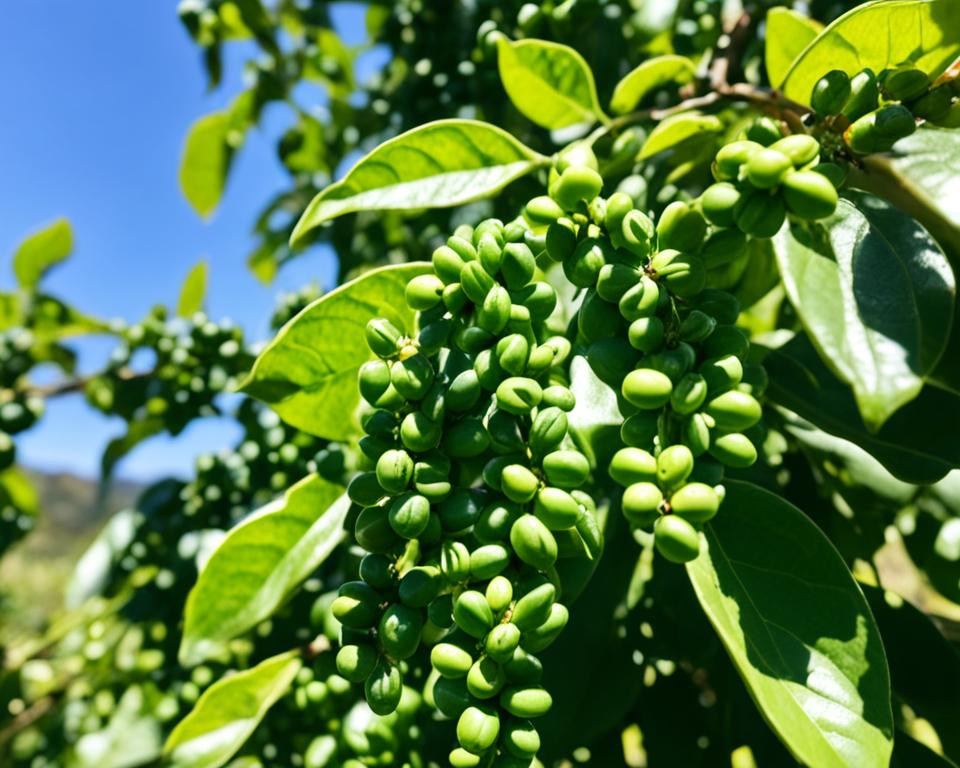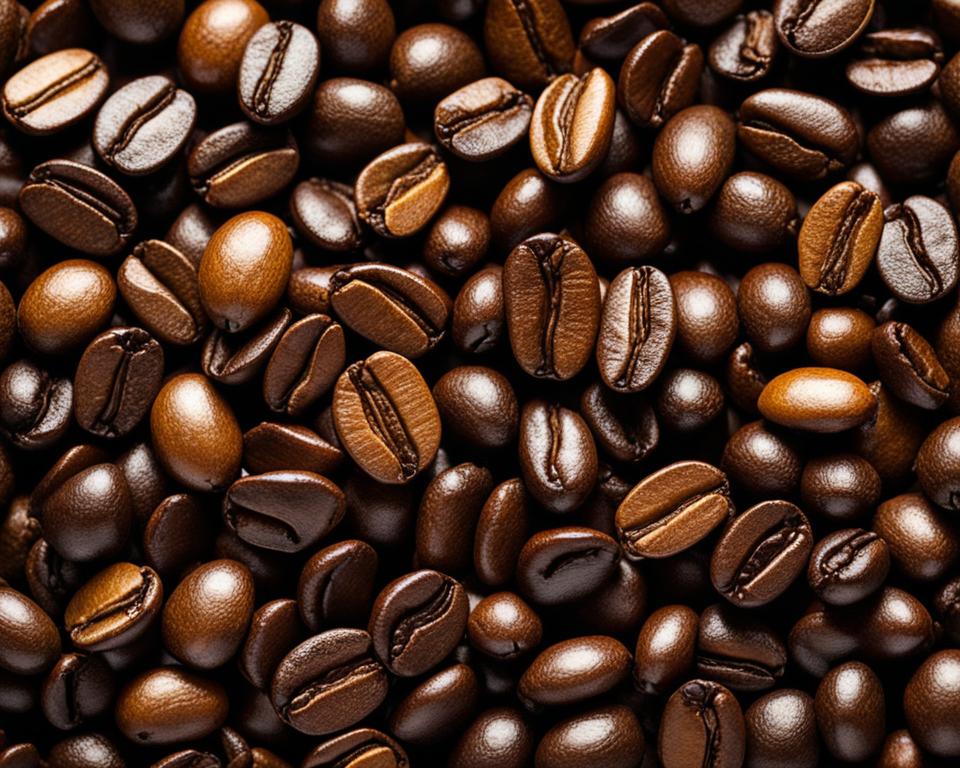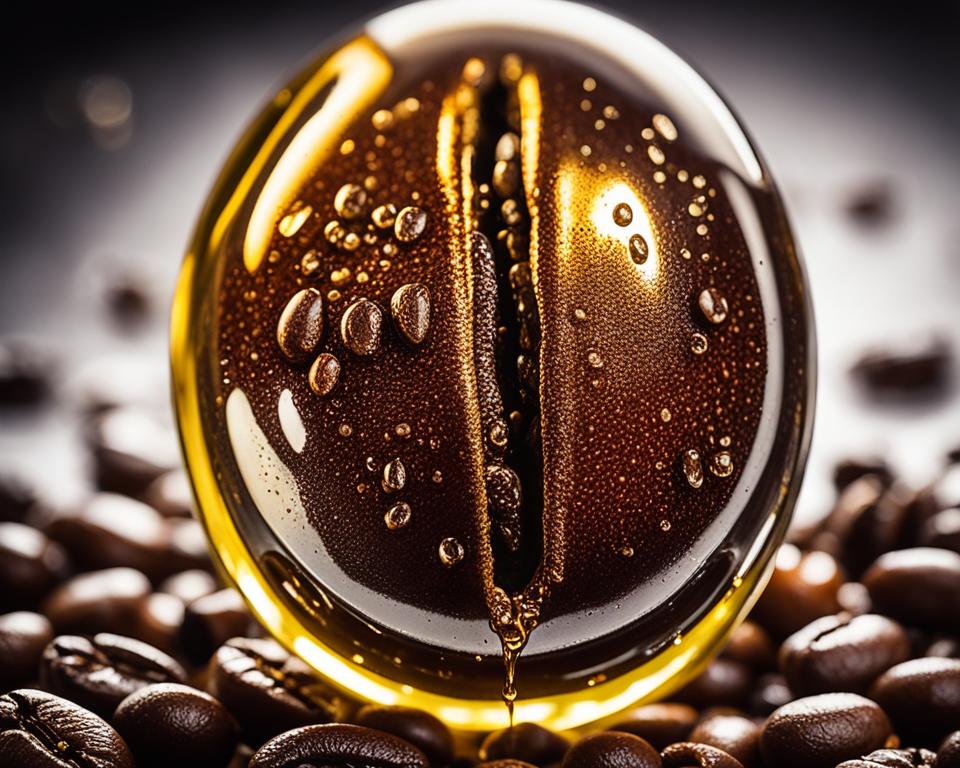Why are coffee beans so oily? Did you know that up to 18% of a coffee bean’s weight consists of oils? That’s right!
These natural oils are crucial to the coffee bean quality and flavour we all love. When you open a fresh bag of beans and see those glossy coffee beans, you’re actually looking at a key indicator of coffee bean freshness.
As I chatted with some expert baristas and roasters, I learned that these oils play a significant role in the brewing process and the overall sensory experience. Fresh coffee oils enhance the richness and complexity of the flavours in your cup. However, their presence can also affect how you brew coffee, impacting everything from extraction to the final taste. Understanding why coffee beans are oily is essential for any coffee lover aiming to get the most out of every brew. So, let’s dive in and explore what makes those shiny beans so special!
Introduction to Oily Coffee Beans
Ever noticed how some coffee beans have a shiny, oily surface? This is a topic of great interest to many coffee aficionados. Understanding the causes of oily coffee beans can provide insight into the quality and character of your brew.
What makes coffee beans oily?
Coffee beans naturally contain oils, primarily composed of lipids. These oils are locked within the bean’s structure. However, certain factors cause these oils to reach the bean surface, making them appear oily.
One of the primary causes of oily coffee beans is the process of roasting. As the beans are heated, their cells break down, releasing the stored oils. The higher the temperature, the more these oils are driven out.
Moreover, the type of beans and their age can also influence their oiliness. Fresher beans are less likely to show surface oil immediately, but as they age and are exposed to air, the oils can emerge.
So, it’s a blend of natural composition and external factors like time and environment that make coffee beans oily.
The Impact of Roasting on Coffee Beans
Roasting is not just about heating up the beans; it’s an art. Different coffee roasting techniques can profoundly affect bean surface oil. For instance, air roasting, which uses a stream of hot air, might result in less visible oil on the surface compared to drum roasting, where beans tumble in a heated drum.
The latter tends to produce beans with more surface oil due to the direct contact with the roasting drum’s hot surfaces.
The roasting duration and temperature also play a crucial role. A longer roast at higher temperatures will generally coax more oils out of the beans, leading to a more pronounced shiny appearance.
Contrastingly, a light roast might not show much oil since the beans haven’t heated enough for the oils to become visible.

According to experts from well-known roasters like Stumptown Coffee Roasters, the level of oiliness sought in premium beans is a balance. Too much visible oil might indicate an over-roasted or stale bean, while some oiliness can enhance flavour and texture.
Ultimately, whether you prefer your beans oily or not can be a matter of personal taste. However, knowing about the causes of oily coffee beans and how different coffee roasting techniques influence bean surface oil can enhance your appreciation of your daily cup.
Natural oils in coffee beans
When it comes to coffee, natural oils play a significant role in creating the perfect cup. Understanding the types of oils present and their functions can greatly enhance your appreciation of coffee.
Types of natural oils present
Coffee beans are packed with various natural oils that contribute to their unique characteristics. Among these, bean lipids and coffee bean natural oils stand out.
These oils are vital in determining the flavour and aroma of your coffee. They include triglycerides, diterpenes, and sterols, which all bring something special to every brew.

The Role of Lipids in Coffee Beans
Bean lipids are essential in providing coffee with its rich, full-bodied taste and smooth mouthfeel. These healthy coffee oils not only enhance flavour but also contain antioxidants, offering potential health benefits.
Scientific studies highlight that these oils can improve heart health and reduce inflammation, making your coffee not just delicious but also beneficial.
According to nutritional experts, the lipid content can vary based on the coffee variety, with robusta beans often having higher concentrations. This variance adds another layer of complexity and richness to different types of coffee.
Next time you enjoy a cup, remember that these natural oils are a big part of what makes it so special.
The Roasting Process and Oily Coffee Beans
Understanding how different roasting levels affect the oiliness of coffee beans is key to mastering the perfect cup. The intricate process changes the bean’s chemistry, influencing the surface oil expression.
Light vs. Dark Roasts: Oiliness Differences
Comparing light, medium, and dark roasts reveals noticeable differences in oiliness. Light roasts have less surface oil because they undergo a shorter roasting period.
This limited roasting time means their internal oils remain mostly unexpressed.
Medium roasts start to show some oil, striking a balance between flavour development and oil retention. On the other hand, dark roasts are visibly oilier.
Extended roasting times draw oils to the surface, creating that glossy appearance we often associate with rich, bold flavours.
How Different Roasting Levels Affect Oil Release
The coffee bean roasting levels significantly influence the coffee roast profile and oil expression in the beans. During roasting, beans endure complex chemical changes.
Maillard reactions and caramelization processes intensify, especially in darker roasts, causing internal oils to migrate outward.
Research indicates that the ideal roast level maximises flavour without excessive oiliness that could clog coffee machines. Notably, experienced roasters like Starbucks and Peet’s often prefer specific roasting profiles to achieve their signature flavours while managing oil expression efficiently.
Is oiliness a sign of freshness?
It’s common to wonder if a glossy coffee bean appearance signifies coffee freshness indicators. This shiny surface often raises questions about whether it’s a true reflection of the bean’s quality.
Let me share what I’ve discovered through my experiences and chats with coffee experts.
The idea that fresh coffee bean characteristics include oiliness is popular, but it isn’t always accurate. While a glossy coffee bean appearance can indicate the presence of natural oils, these oils can eventually wear off, impacting the coffee’s taste and aroma.
So, it’s not solely about appearance.
I recently spoke with some established coffee retailers, and they shared their tips on identifying coffee freshness indicators. They emphasised that freshness is a mix of factors, including the roast date, storage conditions, and the coffee bean’s overall feel and aroma.
Relying solely on a glossy coffee bean appearance can be misleading.
Remember, the oiliness decreases over time. Fresh coffee bean characteristics like aroma, flavour, and texture can change as oils evaporate.
Hence, oiliness might diminish, but that doesn’t always mean the coffee is no longer fresh.
In conclusion, while a glossy coffee bean appearance can be one of the coffee’s freshness indicators, it’s essential to consider other factors too.
Next time, pay attention to the roast date and storage techniques to ensure you’re enjoying a truly fresh cup of coffee.
Does the Oily Nature of Coffee Beans Affect the Diuretic Properties of Decaffeinated Coffee?
The oily nature of coffee beans contributes to their flavor and freshness, but can also influence how they affect the body. While decaf coffee effects generally include mild diuretic properties, the oil content may alter hydration levels differently than regular coffee. Understanding this balance is essential for coffee enthusiasts.
Does the oiliness affect the flavour of coffee?
Have you ever wondered how the oiliness of coffee beans impacts the flavour profile of your morning brew? It’s fascinating to discover how these oils can both enhance and detract from the taste experience.
Let’s break it down into positive and negative aspects.
Positive Flavour Aspects
The natural oils in coffee beans can play a significant role in unlocking rich, delightful notes. Think of those comforting hints of nuttiness, chocolate, and caramel that make each sip a sensory pleasure.
These oils contribute to a fuller body and smoother texture, enhancing the overall coffee flavour profile. Many coffee enthusiasts, myself included, appreciate the depth and complexity that the right amount of oil can add to their favourite cup.
Negative Flavour Aspects
On the flip side, too much oiliness can lead to unfavourable outcomes. Excessive oils might bring out an unpleasant bitter or burnt taste, overshadowing the more subtle flavours we love.
It’s a delicate balance; more isn’t always better when it comes to coffee bean texture. A noticeable layer of oil on the beans can sometimes be a red flag for over-roasted coffee, resulting in an acrid brew.
I’ve come across a variety of opinions from coffee drinkers regarding their tasting experiences with oily beans. Some find it enhances their enjoyment, while others feel it disrupts it.
Insights from a flavour chemist also revealed that changes in the compounds of these oils during brewing could significantly influence coffee’s final flavour notes.
So next time you’re savouring your cup, take a moment to consider how the oiliness of your beans is shaping your flavour experience.
FAQ
What makes coffee beans oily?
The natural composition of coffee beans includes inherent oils that rise to the surface during roasting. Factors such as roasting temperature and time affect how oily the beans appear. Different roasting methods, like air roasting vs. drum roasting, can produce varying levels of oiliness.
How does the roasting process impact the oiliness of coffee beans?
The roasting process is crucial in determining the oiliness of coffee beans. When beans are roasted, the oil inside them starts migrating to the surface. The higher the temperature and longer the roast, the more oil is brought to the exterior. This makes dark roasts typically appear oilier than lighter roasts.
What types of natural oils are present in coffee beans?
Coffee beans contain a variety of natural oils, including lipids, that contribute to the coffee’s body and mouthfeel. These oils include triglycerides, diterpenes, and other compounds that affect the flavour profile and health benefits of the coffee.
What is the role of lipids in coffee beans?
Lipids play a significant role in giving coffee its rich body and mouthfeel. They also influence the flavour and can have several health benefits due to their antioxidant properties. Lipid content varies among different coffee bean varieties and contributes to the overall richness of the brew.
What are the differences in oiliness between light and dark roasts?
Light roasts are generally less oily because the roasting process is shorter and at a lower temperature, which means less oil is brought to the surface. In contrast, dark roasts are oilier as they undergo a longer, higher-temperature roasting process, causing more of the internal oils to emerge.
Does the oiliness of coffee beans indicate their freshness?
While a shiny surface can be an indicator of freshness because it shows the oils have not yet oxidised or evaporated, it’s not solely a guarantee. Over time, even fresh beans stored properly may lose some of their surface oil, yet they still maintain good quality. Consulting with coffee retailers can provide additional insights into freshness indicators beyond just oiliness.
How does oiliness affect the flavour of coffee?
The oils in coffee beans can enhance flavour aspects like nuttiness, chocolate, and caramel notes, making the coffee taste richer. However, excessive oiliness can lead to bitter or burnt flavours, overpowering the desired taste. Finding a balance in oiliness is essential for a pleasant drinking experience.




